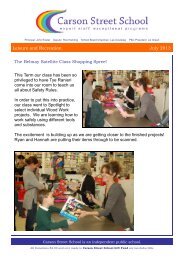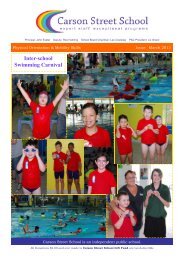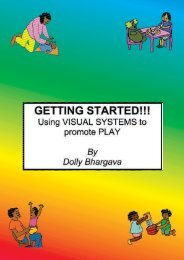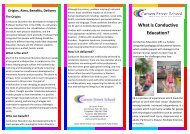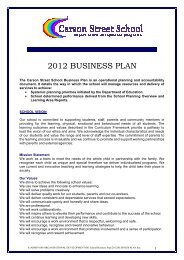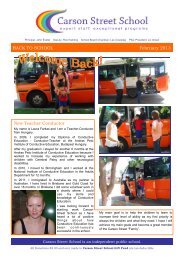Getting Started: Using Visual Systems to Promote Communication
Getting Started: Using Visual Systems to Promote Communication
Getting Started: Using Visual Systems to Promote Communication
You also want an ePaper? Increase the reach of your titles
YUMPU automatically turns print PDFs into web optimized ePapers that Google loves.
43<br />
Self-talk involves talking aloud <strong>to</strong> yourself about whatever activity you are<br />
engaged in when your child is around. Keep your sentences short and<br />
simple. For example, as you make lunch, say something like, “I am making<br />
lunch. I need bread. Here's bread. I need peanut butter. Spread it on."<br />
...and so forth, you talk about what you are doing while your child is<br />
watching.<br />
Even before the child starts asking, “Wha dat?” you can use descriptive<br />
language <strong>to</strong> provide the answers. Description provides words, labels, and<br />
descriptions of objects and actions in the. For example, in describing what<br />
your child is playing with, <strong>to</strong>uching, or seeing, you might say, “That is a fast<br />
car. It is red. Uh-oh, one of the doors is broken. See, this one is broken.”<br />
Andrea and Jayden<br />
are having a tea<br />
party. Andrea<br />
engages in self talk<br />
as she drinks her<br />
cup of tea by saying<br />
“I’m drinking a cup<br />
of tea. Its got milk<br />
and sugar. Yum<br />
Yum!<br />
Tiffany is describing<br />
Grace’s actions<br />
during doll play, by<br />
saying, “You’re<br />
giving dolly a<br />
cuddle”.’<br />
<strong>Using</strong> expansion language means adding more information <strong>to</strong> the words<br />
that your child uses <strong>to</strong> talk about objects or actions. What you are basically<br />
doing by adding more words is revising and completing your child’s speech,<br />
but you are doing it without directly correcting what your child has said. This<br />
method requires careful listening on your part. For example, your child<br />
might say, “Car.” Considering the where, when, and circumstance you<br />
might reply, “Yes, that is John’s car.”<br />
Andrea is expanding<br />
on Jayden’s<br />
verbalisation “book”<br />
by saying “You’re<br />
giving dolly a book”+<br />
signing ‘give book’.<br />
Expansion-plus can be used once your child is using his or her own short,<br />
simple sentences, you can add descrip<strong>to</strong>rs, prepositions, pronouns, and<br />
verbs <strong>to</strong> make the sentences more complete. For example your child might<br />
say, “John, go bye-bye.” You might respond, “Yes, John is going home”.<br />
You are not correcting your child’s sentence so much as adding more<br />
information <strong>to</strong> it. As another example, if your child says, “Car go” you might<br />
respond, “We are driving the car <strong>to</strong> the grocery s<strong>to</strong>re”.<br />
Develop your child’s ability <strong>to</strong> follow instructions gradually by using speech<br />
and visual supports. Start with one instruction at a time. When they start <strong>to</strong><br />
get this right most of the time, build your instruction <strong>to</strong> include 2 parts (for<br />
example, “Wash your hands, then get changed”).<br />
Tiffany is<br />
expanding on<br />
Grace’s<br />
verbalisations of<br />
“dolly bottle” by<br />
saying “Dolly’s<br />
thirsty!!! You’re<br />
giving dolly a bottle<br />
of milk. She is<br />
hungry” + signing<br />
‘thirsty, you, milk<br />
dh ’<br />
Andrea asks Jayden<br />
<strong>to</strong> turn the page in<br />
the book by using<br />
speech + signing<br />
‘turn the page’ +<br />
tapping on the page.



